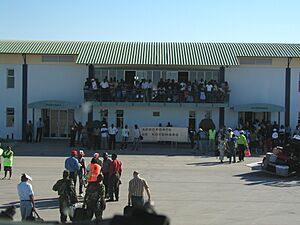Ondjiva facts for kids
Quick facts for kids
Ondjiva
Vila Pereira d'Eça
|
|
|---|---|
|
Commune
|
|
| Country | |
| Province | Cunene |
| Municipality | Cuanhama |
| Area | |
| • Total | 2,100 km2 (800 sq mi) |
| Elevation | 1,098 m (3,602 ft) |
| Population
(2014)
|
|
| • Total | 187,914 |
| • Density | 89.5/km2 (232/sq mi) |
| Time zone | UTC+1 (WAT) |
| Climate | BSh |
Ondjiva, once known as Vila Pereira d'Eça, is a town in Angola. It has a population of about 187,914 people (as of 2014). Ondjiva is the capital city of the Cunene Province. It is located in the very south of Angola, only about 42 kilometres (26 mi) from the border with Namibia. This town was traditionally the home of the Ovambo king of the Oukwanyama tribe. Ondjiva was greatly affected by the Angolan Civil War (1975-2002).
Contents
History of Ondjiva
Early Mission Station
The first mission station in Ondjiva was set up in 1891. It was started by Friedrich Meisenholl and August Wulfhorst from the Rhenish Mission Society. They got help from Friedrich Bernsmann and permission from King Weyulu Hedimbi. The missionaries thought Ondjiva was in German South West Africa, but they later found out it was not. The next year, they built another mission station called Omupanda.
Friedrich Meisenholl stayed in Ondjiva for about four years. He had to leave because he became very sick. Wilhelm Stahlhut took his place in the mid-1890s. Sadly, all three of Stahlhut’s children died in Africa. He himself got sick and passed away in 1900. His wife stayed in Africa for many years after that.
In August 1915, King Mandume had the mission station burned down. The German missionaries had to escape to Ondonga in South West Africa. Later, Ondjiva became a Catholic mission. It is now the main church city for the Ondjiva Diocese.
Rebuilding After Conflict
Ondjiva was badly damaged during the Angolan Civil War. This war lasted from 1975 to 2002. During the war, the city's government had to move away for a while. By 1989, most people had left Ondjiva. By 1999, fewer than 5,000 people lived there.
After peace came in 2002, people started rebuilding Ondjiva. At first, the city grew slowly. But then, many people who had left came back home. New people also moved to Ondjiva from other parts of Angola, especially from Huíla Province. This happened between 1998 and 2000.
People and Languages
Ondjiva has always been a main center for the Kwanyama people. Their language, Oshikwanyama, is a common dialect of the Oshiwambo language. After the Angolan Civil War, many new people moved to Ondjiva. They came from other areas of Angola, like Huíla Province.
About 30.4 percent of the people in Ondjiva speak Portuguese. This is less than in Angola's capital city, Luanda. About 28.2 percent of the people in Ondjiva speak Kwanhama.
City Layout
Ondjiva is made up of 12 different neighborhoods. These are called bairros.
- Pioneiro Zeca I
- Pioneiro Zeca II
- Bangula I
- Bangula II
- Kafito I
- Kafito II
- Kachila I
- Kachila II
- Naipalala I
- Naipalala II
- Castilhos
- Kakuluvale
Getting Around
Ondjiva Airport
Ondjiva has an airport called Ondjiva Pereira Airport. It is also known as Aeroporto 11 de Novembro. The airport is located northwest of the city center. You can fly from this airport with TAAG Angola Airlines. There are flights to Luanda, Catumbela, and Kuito.
Future Rail Connection
There are plans to build a railway line to Namibia. This line would connect to the Moçâmedes Railway. However, this railway has not been built yet.
Annual Trade Fair
Ondjiva hosts a special event every July. It is a 15-day annual trade fair. During this fair, companies can show off their newest products and services. It's a great way for different businesses to connect and share what they do.
Famous People from Ondjiva
- Marcelina Vahekeni: She was Miss Angola in 2012. She also represented Angola in the Miss Universe 2012 beauty pageant.
See also
 In Spanish: Ondjiva para niños
In Spanish: Ondjiva para niños



